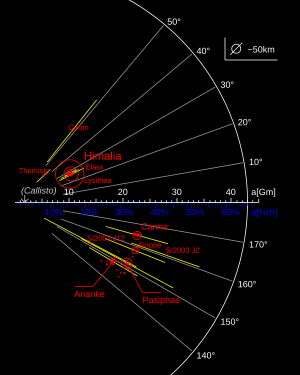Himalia group facts for kids

The Himalia group is a group of prograde non-spherical moons of Jupiter that follow similar orbits to Himalia and are thought to have a common origin.
The known members of the group are (in order from closest to farthest from Jupiter):
The orbit estimate of the recently found moon S/2000 J 11 also qualified it as a member of the group (it appeared to have the same inclination, and a slightly bigger semi-major axis) but its orbit is not known exactly and the mean orbital elements have not yet been calculated.
The International Astronomical Union (IAU) reserves names in -a for the moons in this group.
Characteristics and origin
The objects in the Himalia group have semi-major axes (distances from Jupiter) in the range of 11,150,000 and 11,750,000 km, inclinations between 26.6° and 28.3°, and eccentricities of between 0.11 and 0.25. All moons in the group are grey similar to C-type asteroids. It has been suggested that the group could be a remnant of the break-up of an asteroid from the main asteroid belt. The radius of the parent asteroid was probably about 89 km, only a bit bigger than that of Himalia, which retains approximately 87% of the mass of the original body. This indicates the asteroid was not heavily disturbed.
See also
 In Spanish: Grupo de Himalia para niños
In Spanish: Grupo de Himalia para niños


